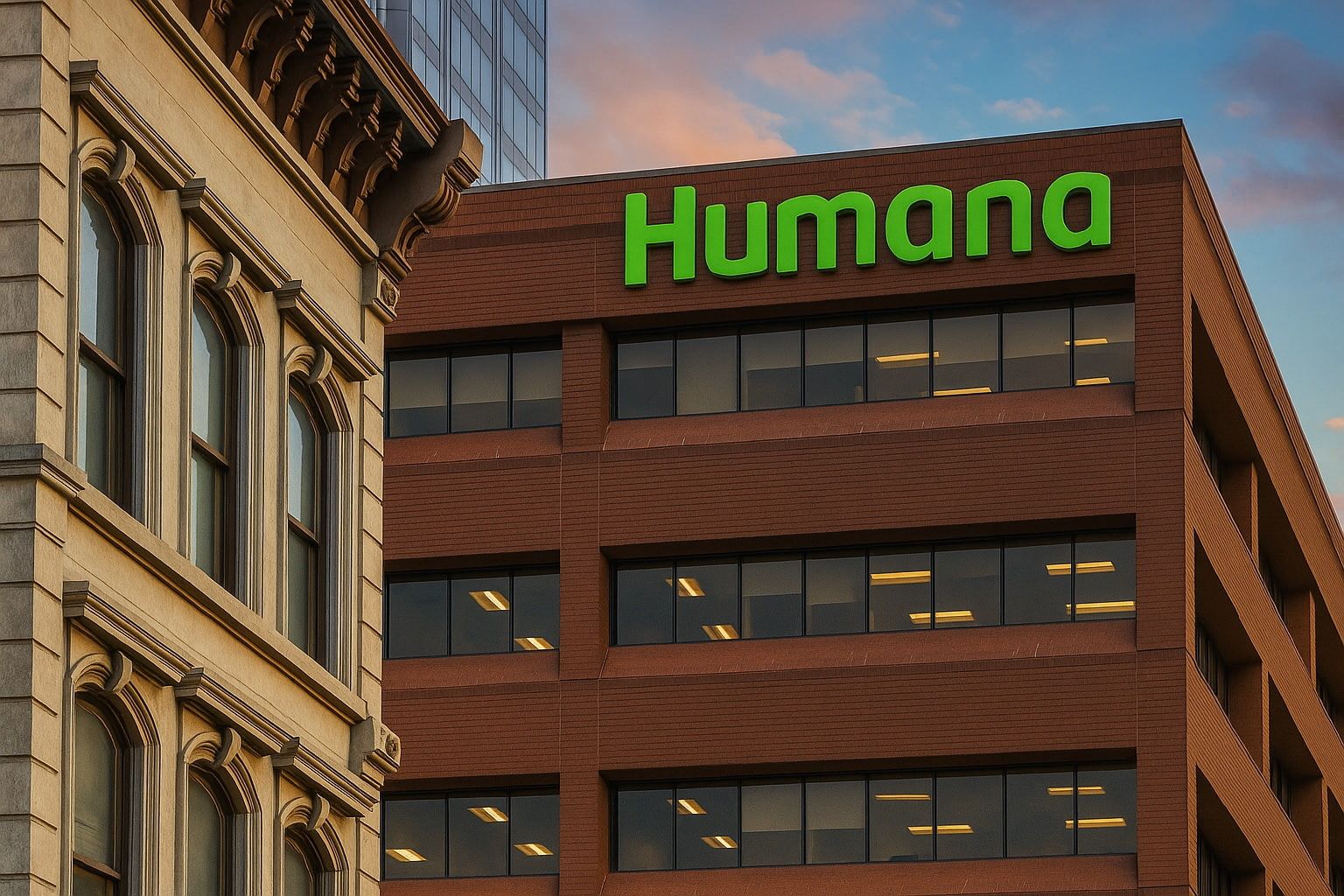- Current Price & Trend: Humana’s stock trades around $269 per share on Nov 5, 2025, after a recent earnings report. It’s roughly flat over the past month, recovering from mid-October lows near $261 [1] [2]. The stock is about 30% above its 52-week low of $206, but ~15% below this year’s high of $315 [3]. Year-to-date performance is modest as investors remain cautious.
- Q3 2025 Earnings Beat:Humana topped expectations in Q3 2025. Adjusted EPS came in at $3.24, beating consensus (~$2.85–$2.91) [4] [5]. Revenue was $32.65 billion, slightly above estimates (~$32.0 billion) [6]. Medical cost ratio was 91.1%, in line with company forecasts (analysts expected ~90.9%) [7] – indicating cost pressures were as anticipated. GAAP net income was $195 million (EPS $1.62) after one-time costs [8].
- Guidance Updated: Humana reaffirmed full-year adjusted EPS guidance at roughly $17.00 [9], signaling no change to its core earnings outlook. However, it cut its GAAP earnings forecast to about $12.26 per share (from $13.77) due to “heightened medical care costs” and charges [10] [11]. The insurer also warned that 2025 medical expenses may hit the upper end of its 90.1%–90.5% cost ratio range [12], underscoring persistent inflation in healthcare costs.
- Stock Reaction & Valuation: Investors were lukewarm on the news – shares fell ~4% pre-market on Nov 5 [13]. At ~$269, Humana trades at about 16× forward earnings (approx. 19× on a GAAP basis) [14]. The stock’s dividend yield is ~1.3% (annual dividend $3.54) [15], with 15 consecutive years of payouts [16]. Current valuation is in line with peers in the health-plan sector, reflecting moderate growth expectations.
- Medicare Focus & Membership:Humana is a top Medicare Advantage insurer, deriving the bulk of its revenue from Medicare plans for seniors [17]. For 2025, the company projects a drop of ~425,000 Medicare Advantage members, which is actually better than previous forecasts (a loss of up to 500,000) thanks to stronger retention and sales [18]. This anticipated ~7% membership decline stems largely from a quality ratings setback – a major Humana plan’s Medicare star rating fell from 4.5 to 3.5 stars, impacting enrollment and bonuses [19] [20]. Encouragingly, Humana noted it has adjusted plan benefits and pricing, and “expects most of its new members to be on higher-rated plans” moving into 2026 [21].
- Quality Ratings & Regulatory Overhang: The ratings downgrade triggered significant challenges. In October, Humana lost a court bid to overturn CMS’s 2025 star ratings, meaning the lower ratings stand [22] [23]. Plans with higher stars receive bigger government bonus payments, so this will likely reduce Humana’s revenue and profits in 2026 [24]. Management is “exploring all legal options” [25] but acknowledges the decline in ratings will hurt 2026 results. Humana estimates the ratings cut could cost it hundreds of millions (even “potentially billions”) in bonus revenue and risk member losses [26] [27]. This overhang has made the company cautious about providing 2026 guidance. Analysts note that the “lack of clarity” for 2026 is weighing on sentiment, with investors bracing for a flat or down year as these headwinds hit [28].
- Financial Health: Despite near-term profit pressures, Humana’s core business remains large and profitable. Trailing 12-month revenue is $126 billion [29], up ~10% year-over-year, though net income has been dented by one-time charges. Humana has been repricing premiums and adjusting benefits to restore margin – a strategy it says is working to offset two years of elevated post-pandemic healthcare utilization [30] [31]. The company’s cost-control efforts (negotiating rates, care management, preventive programs) are aimed at ensuring medical trends stay within forecasts. Its insurance benefit ratio in Q3 was 91.1%, matching expectations [32], suggesting no new negative surprises in claims. Humana continues to generate strong cash flows and has a conservative debt profile (credit ratings in the BBB range), helping it maintain its dividend and invest in growth.
- Company Background & Sector Position: Founded in 1961 and based in Louisville, KY, Humana has evolved into one of America’s largest health insurers, serving ~17 million members (primarily Medicare Advantage, along with some Medicaid, TRICARE military contracts, and specialty plans). Uniquely, Humana has exited most employer-sponsored commercial insurance to focus on government-backed programs. In 2017, a proposed $37 billion merger with Aetna was blocked by regulators, keeping Humana independent. Today, it competes with giants like UnitedHealth Group (the #1 Medicare Advantage player), CVS/Aetna, Elevance Health (Anthem), and Cigna. Humana’s Medicare Advantage market share is second only to UnitedHealth, making it a critical player in the senior health market [33]. This focus positions Humana to benefit from an aging U.S. population and the steady migration of seniors into private Medicare plans. However, it also exposes the company to regulatory risk, since revenues depend heavily on Medicare funding formulas and quality bonuses.
- Leadership & Strategy: After a decade at the helm, CEO Bruce Broussard stepped down in 2024. His successor Jim Rechtin (former CEO of Envision Healthcare) took over leadership on July 1, 2024 [34]. Rechtin is emphasizing “discipline and prudence” in forecasting and execution as Humana navigates this challenging period [35] [36]. Early in his tenure, Humana withdrew its initial 2025 earnings outlook due to the star-rating hit, resetting expectations at a lower level [37]. Now, under Rechtin’s guidance, the company is doubling down on its integrated care strategy. Humana’s game plan is to improve margins by 2027 (targeting Medicare Advantage profit margins back above 3% [38]) through a combination of higher premiums, cost containment, and quality improvements. On the Q3 call, Rechtin stressed “building credibility” by setting achievable targets and navigating the next 24 months conservatively [39]. In practice, this means Humana is not chasing aggressive growth in the short run; instead it’s focused on operational fixes – raising star ratings, appealing the ratings where possible, and ensuring medical cost trends are kept in check – to set a foundation for future growth.
- Recent Developments – M&A and Partnerships: Humana has been actively expanding its healthcare services arm (CenterWell) to complement its insurance business. In 2025 it announced a notable acquisition: CenterWell is acquiring The Villages Health, a group of 10 clinics (8 primary care, 2 specialty centers) serving 55,000 patients in the large retirement community “The Villages” in Florida [40] [41]. The Villages Health had fallen into bankruptcy (due to Medicare billing issues), and Humana moved to scoop up its assets as a “stalking horse” bidder [42]. A U.S. bankruptcy court approved Humana’s bid in September, and the deal is expected to close in Q4 2025 [43] [44]. This investment bolsters Humana’s presence in Florida and brings a captive patient population into its orbit. Importantly, CenterWell clinics operate on a payor-agnostic basis [45], meaning even non-Humana patients can use them – but owning the clinics can help Humana better manage care (and costs) for its own members in those areas.
- Strategic Partnerships: Humana is also growing via value-based care partnerships. In August 2025, it announced new agreements to expand specialized care for members with musculoskeletal (MSK) conditions [46]. Humana added partnerships with Vori Health and HOPCo – alongside an existing deal with TailorCare – to provide coordinated care for Medicare Advantage members with chronic bone and joint issues [47] [48]. Starting in late 2025, these programs are being rolled out in markets like Dallas, Denver, and Atlanta [49]. Through such deals, Humana aims to improve patient outcomes and reduce costs by offering members access to teams of specialists, care navigators, and education in managing MSK conditions [50]. Dr. Bryan Loy, Humana’s corporate medical director, noted that “whole-person care is crucial… these value-based partnerships provide a care team enhancing holistic support, improving care delivery and outcomes.” [51]. In addition, Humana has a joint venture with private equity firm Welsh Carson to open 100 new CenterWell primary care clinics over 2024–2025, and it continues to invest in in-home care and pharmacy services (CenterWell Home Health and Pharmacy). These moves all align with Humana’s strategy to control more of the healthcare value chain for its members – an approach also pursued by rivals like UnitedHealth (Optum division) and CVS Health (via its Aetna and MinuteClinic/HealthHUB units).
- Market & Competition: The health insurance sector in 2025 has faced headwinds from rising utilization and medical inflation. Humana’s challenges are not unique – peers like UnitedHealth and Elevance have also reported higher-than-normal demand for surgeries, outpatient visits, and even a rebound in elective procedures that were deferred during the pandemic [52]. This has squeezed profit margins across Medicare Advantage providers. However, Humana was hit especially hard because of its concentrated exposure to Medicare and the one-time impact of the star rating downgrade. By contrast, some competitors have more diversified portfolios (for example, UnitedHealth has a large commercial and healthcare services business to offset Medicare swings). In the stock market, managed care stocks lagged in 2024 amid these cost concerns, and Humana was among the hardest hit – its shares fell over 40% in 2024 [53]. Coming into 2025, sentiment improved as investors saw medical cost trends stabilizing and valuations becoming attractive. Indeed, Humana’s stock rallied from the low $200s in early 2025 up to the $300+ range by mid-year. But the October star-rating news halted that rally, and HUM shares slid back into the $260s. Relative to the S&P 500, Humana has underperformed over the past two years, reflecting the uncertainty around its Medicare business. That said, many analysts see the sector’s fundamentals turning a corner: an aging population means Medicare Advantage enrollment is still growing industry-wide (~8–10% annually), and insurers are adjusting premiums for 2024–2025 to account for higher costs, which could restore profitability. Humana itself raised its MA plan premiums/pricing for 2024 and again for 2025, which should aid revenue per member. Competition for Medicare enrollees remains intense – during the current Annual Enrollment Period (Oct 15–Dec 7, 2025), Humana is vying with United, CVS/Aetna, and dozens of regional plans for new sign-ups. Humana’s selling point is often its high-quality integrated care (it consistently had strong star ratings historically, plus offerings like dental, vision, SilverSneakers fitness benefits, etc.), but the recent rating slip means rivals might poach some market share this cycle. The company is counting on its brand in seniors’ markets and maintaining rich benefits to stay competitive until it can regain top quality scores.
- Analyst Sentiment & Price Targets: Wall Street analysts are mixed but generally positive on Humana. According to Bloomberg and Yahoo Finance, ~25 analysts cover HUM, with the consensus rating around a “Buy” (many at Buy/outperform, some holds, few sells). The average 12-month price target is about $295–$296, implying a modest ~5% upside from current levels [54]. Price forecasts vary widely, reflecting uncertainty: recent targets range from a low of ~$235 (more bearish analysts worried about 2026 earnings) up to highs of $340+ from bullish analysts [55] [56]. For example, Raymond James reiterated an Outperform rating after Q3 and set a $340 target, expressing confidence that Humana can manage through the star-rating setback [57]. They acknowledge challenges in regaining 4-star status for 2026, but still see the stock as undervalued for a leading franchise [58]. On the bullish end, some view Humana as a long-term winner in a growing market – “the Medicare Advantage opportunity remains enormous,” as one analyst put it – and believe current headwinds are temporary. Wolfe Research likewise upgraded the stock in October, raising its target to $313 and maintaining Outperform [59] [60]. Wolfe’s analysts noted that the unchanged 2026 star ratings (3.5 stars again for the big contract) actually indicate underlying improvement, since CMS raised the performance cut-points – Humana essentially avoided further slippage. They highlighted Humana’s strategy of diversifying members into a different 4.5-star contract to mitigate the impact, and pointed out that over 80% of Humana’s members will have stable benefits in 2026 despite the turmoil [61] [62]. Wolfe updated their model to assume 2025 EPS of $17 and 2026 EPS of $13.50, noting this still values HUM at only ~8.5× its “earnings power” (when adjusting for the temporary dip) – an attractive valuation [63]. On the more cautious side, Cantor Fitzgerald has a Neutral rating with a $290 target [64], essentially seeing the stock as fairly valued. They and others want to see proof that medical cost trends truly moderate and that Humana can navigate policy changes (for instance, Cantor flagged changes in Indiana’s Medicaid that could affect Humana’s small Medicaid business) [65]. In general, short-term earnings forecasts for 2026 have been cut by many analysts due to the lost bonus revenue – consensus expects a drop in EPS next year before a rebound in 2027. But longer-term outlooks remain upbeat, with forecasts of EPS growth resuming in the high-single digits beyond 2026 as demographic tailwinds kick in and Humana’s margin initiatives bear fruit. Investors should be prepared for some volatility in the next year, but the prevailing analyst view is that Humana’s fundamentals are intact and the current stock price already reflects a lot of bad news.
- Expert Commentary: Industry experts and company management have weighed in on Humana’s situation. CEO Jim Rechtin has emphasized the need for “prudent” planning and hitting promised targets in order to rebuild investor trust [66]. “We are trying to establish the best way to navigate through the next 24 months,” Rechtin said, underscoring that 2025 will be a reset year [67]. Analysts like Michael Ha of Baird note that after the recent reset, 2025 is expected to be essentially flat, which is “a much lower bar than expected” a year ago [68] – meaning Humana shouldn’t have trouble at least meeting its conservative $17 EPS goal for 2025. The key question is 2026: J.P. Morgan’s analysts wrote that “the overhang from 2026 star ratings will keep sentiment muted until investors see a clear path to earnings growth resumption.” On the positive side, healthcare investor Tom Sachrison told CNBC that “Humana’s core Medicare Advantage business remains one of the best-in-class…once these one-off issues are behind them, we see significant upside” – reflecting a common view among bulls that the current challenges are fixable. In the meantime, Morningstar’s Julie Utterback suggests the stock is undervalued, arguing the market may be “overly discounting the star rating setback”, since Humana’s ongoing quality improvement efforts could pay off by 2027 in regained ratings and bonuses. The mixed commentary shows that while confidence in Humana’s long-term trajectory exists, the company will be under scrutiny in the coming quarters to execute on its promises.
- Risks and Challenges: Investors should keep in mind several risk factors that could impact Humana’s performance and stock price:
- Medical Cost Inflation: A primary risk is that healthcare utilization and costs continue to run higher than Humana anticipated. If hospital admissions, surgeries, or costly new treatments exceed projections, premiums may not cover claims, squeezing margins [69]. Humana sets its plan prices and reserves based on actuarial estimates, but these involve “extensive judgment” and are sensitive to trends [70]. Unexpected spikes (e.g. a severe flu season or new COVID wave) could cause earnings to miss targets. The company itself warns that if it “does not price products properly… or if estimates of benefits expense are inadequate, profitability could be materially adversely affected.” [71] This risk is heightened for Humana because Medicare Advantage operates on fixed annual payments – there’s a lag before premiums can be adjusted to rising costs.
- Regulatory and Policy Risk: Being so dependent on Medicare Advantage, Humana is exposed to government policy changes. Medicare payment rate updates, risk adjustment rule tweaks, or changes to MA bonus formulas can all swing results. For instance, CMS’s new risk adjustment auditing (RADV) could claw back payments from insurers, though a recent report noted the government is behind on hiring coders for these audits [72], delaying potential impacts. Additionally, political pressure on Medicare Advantage is percolating – some critics say private insurers are overpaid relative to traditional Medicare. Any future efforts to curb payments or cap profits in MA could directly hit Humana. Humana also faces antitrust and regulatory scrutiny on any acquisitions (e.g., the DOJ has been vigilant after blocking the Aetna deal). Finally, its small Medicaid segment can be influenced by state policy (as with the Indiana enrollment policy change flagged by analysts) [73].
- Quality Ratings & Bonus Impact: As discussed, the drop in star ratings is a multi-year risk. Not only will 2026 revenue suffer from lower bonuses, but a prolonged period of sub-4-star ratings could make Humana’s plans less attractive, hurting enrollment. Humana is appealing the ratings and aiming to lift them for the 2027 plan year, but there’s no guarantee. If Humana fails to quickly improve plan quality scores, it could face “significantly adverse” effects on revenue, operating results, and cash flows,” the company admits [74]. Also, the lawsuit loss in October sets a precedent – it may be difficult to get legal relief from CMS decisions. This means Humana must fix issues (such as call center service problems that caused the downgrade) operationally. The risk is that it might take several annual cycles to fully restore prior ratings, leaving Humana at a competitive disadvantage in the interim.
- Competition and Market Share: The Medicare Advantage space is crowded and highly competitive. If Humana’s benefits or networks are perceived as weaker due to cost-cutting, or if its temporary star rating slump deters consumers, rivals could capture more market share. UnitedHealthcare, for example, has been growing rapidly and has the scale to absorb short-term cost pressures. Smaller regional plans sometimes undercut on pricing. There’s a risk that Humana’s membership could decline not just in 2025 but also in 2026 if competitors aggressively target its members during open enrollment. Losing members would not only reduce premium revenue but also raise Humana’s per-member admin costs.
- Execution Risks: Internally, Humana is undergoing transitions – a new CEO, integration of acquisitions like the Villages clinics, and large-scale technology and service initiatives. Execution missteps could occur, such as difficulty integrating new clinics or realizing cost synergies. The company’s push into provider services means it now runs clinics and home-care services, which is a different business model from pure insurance and comes with operational risks (staffing, regulatory compliance, etc.). If these ventures underperform or run over budget, it could drag on earnings. Additionally, any negative publicity or brand damage (for instance, if the star rating issue is seen as a sign of declining service) could hurt Humana’s reputation in the eyes of consumers and investors.
- Economic & Other Risks: Broader macro factors like a recession could indirectly impact Humana – for example, if seniors delay care (affecting utilization) or if state budgets for Medicaid tighten. Higher interest rates increase Humana’s cost of capital and make its dividend less attractive relative to bonds. Also, like any large company, Humana faces cybersecurity risks and potential data breaches, which are a particular concern in healthcare. And unpredictable events (pandemics, natural disasters affecting healthcare usage, etc.) remain ever-present wildcards.
- Opportunities and Growth Drivers: Despite the challenges, Humana has multiple opportunities to create value and drive growth in the coming years:
- Demographic Tailwind: The aging U.S. population is a fundamental positive for Humana. About 10,000 Americans turn 65 each day, a trend that will continue well into the next decade. Medicare Advantage enrollment has been growing as a result – seniors increasingly opt for MA plans due to their extra benefits and out-of-pocket caps. Humana, being a focused MA specialist, is well-positioned to capture a share of this expanding pie. Even if Humana stands still in market share, the overall market growth can lift its membership. And if it can solve its quality issues, Humana could resume net membership growth (analysts foresee +8% MA membership in 2026–27) [75]. In short, the long-term secular trend of more seniors choosing private Medicare plans provides a runway for Humana to grow revenue once current headwinds abate.
- Benefit from Repricing Cycle: 2024 and 2025 have been “reset” years where insurers raise premiums and trim benefits to account for higher costs. Humana has repriced its products accordingly. This sets the stage for margin improvement in late 2025 and beyond, assuming healthcare utilization normalizes. Essentially, the tough medicine has been administered: beneficiaries might see slightly higher premiums or co-pays, but for the insurer these adjustments mean each member should become more profitable. If medical inflation cools while these richer premiums are in place, Humana could surprise to the upside on margins. The company also exited unprofitable segments (like employer group insurance) to focus on its best-performing lines. By 2027, Humana expects to restore Medicare Advantage margins to ~3%+ [76], after dipping in 2024–25 – hitting that target would significantly boost earnings versus today.
- CenterWell Integrated Care: Humana’s expansion into provider services (CenterWell clinics, home health, pharmacy) offers a strategic advantage. By owning and partnering in care delivery, Humana can better coordinate members’ healthcare, emphasize preventive care, and reduce duplication or unnecessary services. Over time, this value-based care model can both improve patient outcomes and lower costs (by avoiding hospital admissions, etc.). For instance, the newly acquired Villages clinics and the JV-funded clinics will increase the share of Humana members under a value-based primary care model. These clinics can proactively manage chronic conditions for seniors, which may lead to fewer expensive complications. Humana’s scale in MA gives it the incentive to invest in such care models – and if successful, it could yield a competitive edge (healthier members and lower claims). Additionally, owning providers allows Humana to capture another slice of the healthcare dollar. Analysts have noted that UnitedHealth’s vertical integration via Optum has been a key to its success; Humana is now pursuing a similar path, which could unlock new revenue streams and profit pools outside the traditional insurance margin.
- Partnerships and Innovation: Humana is leveraging partnerships to bolster areas where it can’t easily build expertise in-house. The MSK care collaborations (Vori, HOPCo, TailorCare) are one example, targeting a big cost driver (musculoskeletal issues) with innovative programs [77] [78]. Humana has also partnered in kidney care, oncology, diabetes management, and other high-cost domains via startups and specialized providers. These partnerships are often value-based contracts, meaning the partner gets rewarded for keeping Humana members healthier. Such arrangements can reduce claim costs and improve member satisfaction (an important factor in star ratings). Moreover, Humana’s use of technology and analytics – e.g., its “Enterprise Clinical Operating Model” – helps identify at-risk members for early interventions. As digital health tools evolve (telemedicine, remote monitoring), Humana can incorporate these to manage care more efficiently. There is an opportunity for Humana to differentiate itself as the senior-focused, tech-enabled insurer that delivers better health outcomes. If successful, that could attract more members and perhaps command higher valuations similar to tech-health companies.
- Policy Tailwinds: While regulation is a risk, there can also be positive policy developments. The Medicare Advantage program continues to enjoy bipartisan support due to its popularity with seniors. Each year, CMS typically grants a modest increase in MA payments (to account for medical trend), so revenue per member tends to rise. For 2024, CMS’s rate update was about 3.3%; similar or higher updates in future years (especially if healthcare inflation is higher) will boost Humana’s top line. Additionally, there’s discussion in Washington about expanding certain benefits or value-based insurance design in Medicare – changes that could favor efficient MA plans. Humana’s focus on social determinants of health and supplemental benefits (like food programs, transportation for members) aligns well with CMS’s policy direction, potentially positioning it for demonstration projects or incentives. Finally, if economic conditions worsen and more seniors look to save money, MA plans (with their caps on costs and extra benefits) could see even higher demand versus Medigap + original Medicare, which could indirectly benefit Humana.
- Potential Upside from Stars Improvement: On the flip side of the star rating risk, if Humana is able to substantially improve its plan quality by the next measurement period, there’s upside. Gaining back a 4-star average would restore sizable bonus payments in 2027. Humana has mobilized resources to improve customer service (the call center issue that hurt its score) and other metrics. Early indications show some progress: the company revealed that for 2026 plans, 20% of members are in 4-star-or-higher contracts, and 14% will be in 4.5-star plans – up from virtually none at 4.5 stars in 2025 [79] [80]. This suggests Humana is on the mend in quality. If these efforts continue, Humana could surprise by regaining a large share of high-rated plans by 2027, unlocking a wave of bonus revenue. Analysts like Wolfe see management’s actions (moving members to a smaller, higher-rated contract) as savvy, and it could minimize the financial hit [81]. In short, the current cloud from low ratings might dissipate sooner than the market expects, which would be a catalyst for the stock.
- Outlook:Near-term, Humana is in rebuild mode. 2025 will be about executing on the adjusted plan – hitting that ~$17 adjusted EPS, keeping costs contained, and stabilizing membership declines. The Q3 results showed management is delivering so far (earnings beat, guidance intact) [82] [83]. For 2026, earnings are likely to dip due to the loss of quality bonuses; investors have largely priced this in, but any clarity (or better-than-feared outcomes) will influence the stock. Longer-term (2027+), Humana’s growth story could reaccelerate. With the baby boomer generation aging into Medicare, and if Humana’s initiatives on care delivery and quality bear fruit, the company could return to solid membership growth and margin expansion. Wall Street expects Humana’s EPS to trough in 2026 then resume growth, potentially reaching new highs by 2028–2029. Meanwhile, shareholders are paid to wait via the dividend (which Humana has been growing at ~10% annually in recent years). The stock’s current valuation – roughly market-average P/E for arguably above-average long-term growth prospects – could be seen as an attractive entry if one believes in the firm’s rebound.
In summary, Humana Inc. faces a pivotal moment: it’s balancing short-term earnings headwinds from elevated costs and rating setbacks against strong long-term fundamentals in the Medicare Advantage space. The latest news (Q3 beat and improved membership outlook) provides some relief that management’s corrective actions are working [84] [85]. However, caution prevails as 2026 looms without guidance and with likely flat profits [86]. Investors should watch upcoming quarters for signs of cost trend stabilization, membership retention during open enrollment, and progress on quality metrics. Humana’s ability to navigate these challenges under new leadership will determine if the stock can regain its former strength. For now, the consensus is that Humana will weather the storm: it remains a market leader in a growing sector, with a strategy to adapt and thrive. As one analyst succinctly put it, “Humana’s crown slipped, but it’s far from lost.” The coming year will show how quickly that crown can be polished again.
Sources:
- Reuters – Humana beats quarterly profit estimates on higher premiums, in-line medical costs [87] [88] [89]
- Associated Press via Times Union – Humana: Q3 Earnings Snapshot [90] [91]
- Reuters – Humana loses challenge to 2025 Medicare Advantage ratings [92] [93]
- Reuters – Humana tops estimates on strength in Medicare and primary care (Oct 30, 2024) [94] [95]
- Investing.com – Humana outlines lower MA member loss, but cuts earnings forecast [96] [97]
- Business Wire/FT – Humana Reports Q3 2025 Results; Affirms Full-Year EPS Guidance [98] [99]
- Humana Press Release – New MSK Care Partnerships (Aug 27, 2025) [100] [101]
- Becker’s Payer – Humana to acquire 10 Florida clinics (The Villages Health) [102] [103]
- Investing.com – Wolfe Research raises Humana price target to $313 [104] [105]
- Investing.com – Analyst updates: Raymond James $340; Cantor $290 [106]
- StockAnalysis.com – HUM Key Data (price, valuation, targets) [107] [108]
References
1. www.reuters.com, 2. stockanalysis.com, 3. stockanalysis.com, 4. www.timesunion.com, 5. www.reuters.com, 6. www.timesunion.com, 7. www.reuters.com, 8. www.timesunion.com, 9. ng.investing.com, 10. ng.investing.com, 11. ng.investing.com, 12. www.reuters.com, 13. www.reuters.com, 14. stockanalysis.com, 15. stockanalysis.com, 16. www.investing.com, 17. www.reuters.com, 18. www.reuters.com, 19. www.reuters.com, 20. www.reuters.com, 21. www.reuters.com, 22. www.reuters.com, 23. www.reuters.com, 24. ng.investing.com, 25. www.reuters.com, 26. www.reuters.com, 27. www.reuters.com, 28. www.reuters.com, 29. stockanalysis.com, 30. www.reuters.com, 31. www.reuters.com, 32. www.reuters.com, 33. www.reuters.com, 34. www.nasdaq.com, 35. www.reuters.com, 36. www.reuters.com, 37. www.reuters.com, 38. www.reuters.com, 39. www.reuters.com, 40. www.beckerspayer.com, 41. www.beckerspayer.com, 42. www.beckerspayer.com, 43. www.beckerspayer.com, 44. www.beckerspayer.com, 45. www.beckerspayer.com, 46. policy.humana.com, 47. policy.humana.com, 48. policy.humana.com, 49. policy.humana.com, 50. policy.humana.com, 51. policy.humana.com, 52. www.reuters.com, 53. www.reuters.com, 54. stockanalysis.com, 55. www.zacks.com, 56. www.investing.com, 57. www.investing.com, 58. www.investing.com, 59. www.investing.com, 60. www.investing.com, 61. www.investing.com, 62. www.investing.com, 63. www.investing.com, 64. www.investing.com, 65. www.investing.com, 66. www.reuters.com, 67. www.reuters.com, 68. www.reuters.com, 69. markets.ft.com, 70. markets.ft.com, 71. markets.ft.com, 72. www.investing.com, 73. www.investing.com, 74. ng.investing.com, 75. www.investing.com, 76. www.reuters.com, 77. policy.humana.com, 78. policy.humana.com, 79. ng.investing.com, 80. ng.investing.com, 81. www.investing.com, 82. www.timesunion.com, 83. ng.investing.com, 84. www.reuters.com, 85. www.reuters.com, 86. www.reuters.com, 87. www.reuters.com, 88. www.reuters.com, 89. www.reuters.com, 90. www.timesunion.com, 91. www.timesunion.com, 92. www.reuters.com, 93. www.reuters.com, 94. www.reuters.com, 95. www.reuters.com, 96. ng.investing.com, 97. ng.investing.com, 98. markets.ft.com, 99. markets.ft.com, 100. policy.humana.com, 101. policy.humana.com, 102. www.beckerspayer.com, 103. www.beckerspayer.com, 104. www.investing.com, 105. www.investing.com, 106. www.investing.com, 107. stockanalysis.com, 108. stockanalysis.com







